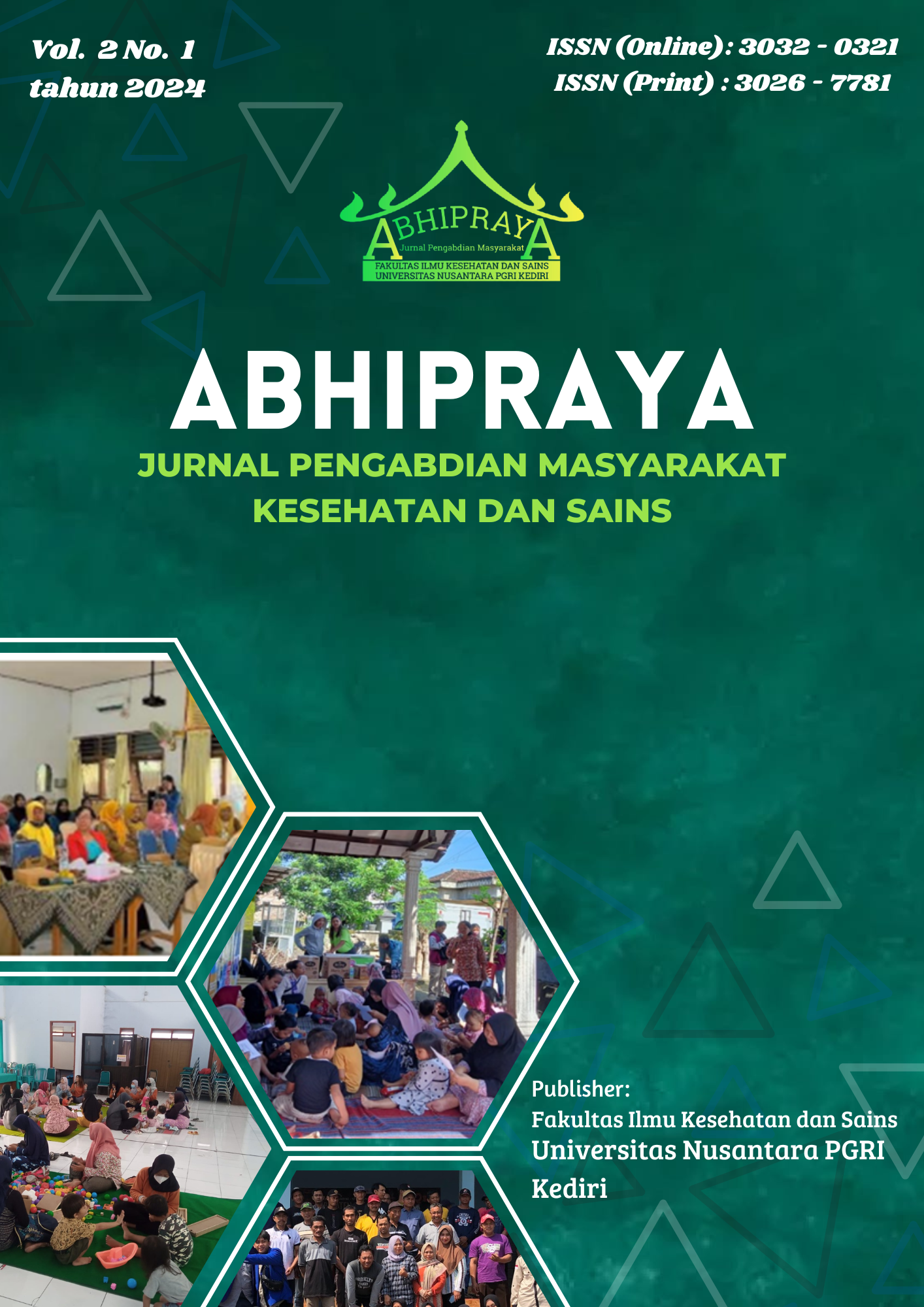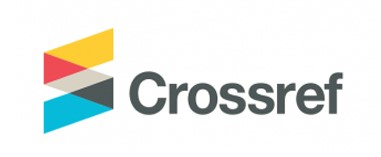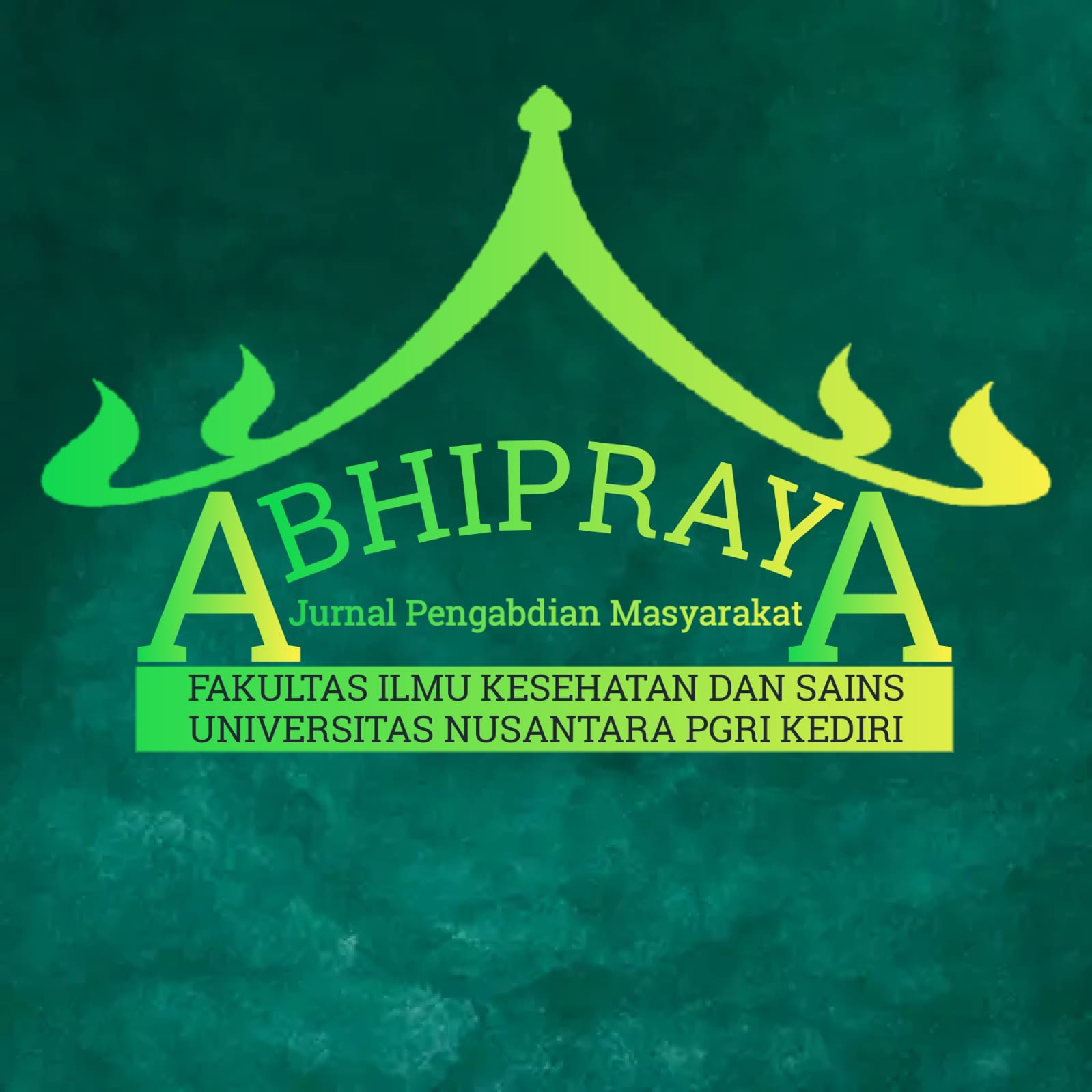Sosialisasi dan Pelatihan Kesehatan Ruminansia kepada Kelompok Ternak Kopi Manis Desa Papar Kecamatan Papar Kabupaten Kediri
DOI:
https://doi.org/10.29407/abhipraya.v2i1.23879Keywords:
training, ruminant livestock health, livestock group, sweet coffeeAbstract
The purpose of this activity is to provide socialization and training on ruminant livestock health to the Kopi Manis Livestock Group in Papar Village, Papar District, Kediri Regency. It is expected that after the socialization and training on livestock health, all members of the Kopi Manis Livestock Group will increase their insight, knowledge, and actions to handle cases of disease in ruminant livestock. This community service activity was carried out using the Participatory Rural Approach (PRA) method, which is a method of educating knowledge and insight to the community or community groups through training, practice, and mentoring. In this PRA method, it was chosen because this PRA method has advantages including the active involvement of community members or groups, in this case the Kopi Manis Livestock Group as the subject. In this socialization and training activity, it was filled with an explanation of various ways to handle ruminant livestock health and how to prevent and treat the types of diseases that usually attack ruminant livestock. As we know, cases of FMD (Foot and Mouth Disease) have caused many problems and great losses for livestock farmers. Also included in this case, when the FMD case broke out, many cattle and goat farmers in the Papar Village area, Papar District, Kediri Regency, experienced paralysis and death in their livestock. Such conditions are certainly very detrimental to farmers. In response to the conditions and problems after the FMD case in Papar Village, Papar District, Kediri Regency, a solution is needed to anticipate the occurrence of FMD cases not recurring or spreading again in the Papar area, so socialization and training are needed on disease prevention and health care for ruminant livestock. It is hoped that with the socialization and training on livestock health, it can provide provisions and knowledge for farmers who are especially members of the Sweet Coffee Livestock Group.
Downloads
References
Adjid, R. M. A. (2020). Foot and Mouth Disease: Exotic Animal Disease that must be Alert of Entry into Indonesia. Indonesian Bulletin of Animal and Veterinary Sciences, 30(2), 61–70. https://doi.org/10.14334/wartazoa.v30i2.2490
Amam, Roni Y., Wildan J.M., Pradiptya A. H. (2019). Kekuatan Sumber Daya (Ekonomi, Lingkungan dan Sosial) dan Pengaruhnya terhadap SDM Peternak dan Kelembagaan Peternak Sapi Perah. 225–235. https://doi.org/10.14334/pros.semnas.tpv-2019-p.225-235
Boimau, D. T., Seran, L., dan Buku, M.N.I. (2022). Studi Etnofarmakognosi Pemanfaatan Tumbuhan Obat Tradisional Untuk Mengobati Penyakit Pada Ternak Oleh Masyarakat Desa Kelle Kecamatan Kuanfatu Kabupaten Timor Tengah Selatan PENDAHULUAN Ternak merupakan hewan peliharaan yang produknya diperuntukan sebagai (2).
Darmawi , Ummu Balqis, dan Masda A. (2023). Penyakit Ternak Ruminansia yang Disebabkan Oleh Virus. Syiah Kuala University Press.
Eko Atmojo, S. (2015). Pengenalan Etnobotani Pemanfaatan Tanaman Sebagai Obat Kepada Masyarakat Desa Cabak Jiken Kabupaten Blora. Jurnal Ilmiah WUNY, 15(1). https://doi.org/10.21831/jwuny.v15i1.3529
Kaunang, S. R., Asyiah, I. N., & Aprilya, S. (2019). Etnobotani (Pemanfaatan Tumbuhan secara Tradisional) Dalam Pengobatan Hewan Ternak oleh Masyarakat Osing di Kabupaten Banyuwangi. Indonesian Journal of Biotechnology and Biodiversity, 3(1), 27–32.
Pertanian, K. (2022). Pedoman Kesiagaan Darurat Veteriner Indonesia Seri Penyakit Mulut dan Kuku. In Direktorat Jendral Peternakan dan Kesehatan Hewan, Kementrian Pertanian (Edisi 3.1, Vol. 7, Issue 1). Direktorat Kesehatan Hewan, Direktorat Jenderal Peternakan dan Kesehatan Hewan , Kementerian Pertanian.
Mutiah, A., Abdullah, A., & Nurlaelah, S. (2018). Identifikasi Peranan Kelompok Sebagai Wahana Kerja Sama pada Kelompok Peternak Sapi Potong pada Peternakan Rakyat. 18(1), 57–62.
Naipospos, T. S. P. (2014). Impor Ternak dan Risiko PMK. Center for Indonesian Veterinary Analytical Studies, 1–3.
Nur Solikin, Sugiono, Y. E. (2019). Kontribusi Perguruan Tinggi Tehadap Kemajuan dan Peningkatan Ekonomi Peternak (Studi Kasus di Desa Ngino Kecamatan Plemahan Kabupaten Kediri). Ekuivalensi, 5(2), 161–173.
Sapta A. (2022). Karakteristik Peternak Sapi Potong di Kecamatan Badas Kabupaten Kediri Pasca Pandemi. Prosiding Semnaskisjar 2 (1), 17-27.
Subronto. (2007). Ilmu Penyakit Ternak II. Universitas Gadjah Mada Press.
Sugito, M. Jalaluddin, M. Delima, M. Isa, M. Akmal. T. R. Ferasyi. Nurliana, Erwin, Rusli. (2023). Penerapan Biosekuriti Tiga Zona Pada Usaha Ternak Ayam Potong Skala Mikro. Jurnal Ilmiah Petamas, 3(1), 29-35. https://doi.org/10.24815/petamas.v3i1.33335.
Downloads
Published
Issue
Section
License
Copyright (c) 2024 Ardina Tanjungsari, Sapta Andaruisworo, Erna Yuniati; Anifiatiningrum

This work is licensed under a Creative Commons Attribution-ShareAlike 4.0 International License.
Authors who publish with this journal agree to the following terms:
- Copyright on any article is retained by the author(s).
- The author grants the journal, right of first publication with the work simultaneously licensed under a Creative Commons Attribution License that allows others to share the work with an acknowledgment of the work’s authorship and initial publication in this journal.
- Authors are able to enter into separate, additional contractual arrangements for the non-exclusive distribution of the journal’s published version of the work (e.g., post it to an institutional repository or publish it in a book), with an acknowledgment of its initial publication in this journal.
- Authors are permitted and encouraged to post their work online (e.g., in institutional repositories or on their website) prior to and during the submission process, as it can lead to productive exchanges, as well as earlier and greater citation of published work.
- The article and any associated published material is distributed under the Creative Commons Attribution-ShareAlike 4.0 International License




















